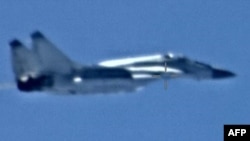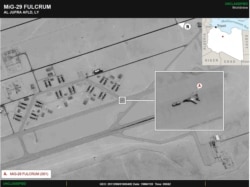Russia is further destabilizing Libya to gain a stronghold in northern Africa, just as it has in Eastern Europe and the Middle East, according to a top official with U.S. Africa Command (AFRICOM).
"Russia is executing the same playbook as successfully employed in Crimea, Ukraine and to a lesser extent in Syria. Russia has proved its willingness to violate sovereign nations, and appears willing to do the same in Africa," Brigadier General Gregory Hadfield, AFRICOM deputy director for intelligence, told reporters Friday.
Hadfield said at least 14 MiG-29 fighter jets and Su-24 bomber aircraft were “flown by members of the Russian military” into Libya “by way of Iran and Syria” to support Russian state-sponsored private military contractors who are helping forces fighting the U.N.-supported Libyan government. He said the U.S. military was also aware of additional Russian cargo planes and personnel that have been brought in, as well as older surface-to-air missiles.
Earlier this week, AFRICOM released imagery of some of the Russian MiG-29s at al-Jufra Air Base in Libya and said the aircraft had been repainted in Syria to camouflage their Russian origin.
The latest air power from Moscow is meant to boost Russian military contractors with the Wagner Group, who have been supporting Libyan strongman General Khalifa Haftar’s Libyan National Army (LNA) in its yearlong offensive against the country’s Government of National Accord (GNA).
Multiple AFRICOM officials have raised concerns that Russia’s interference is extending the conflict in Libya, which Hadfield described as a “stalemate.”
“It really isn’t about winning the war; it’s about developing strongholds,” he said, adding that the Russian aircraft had yet to be used as air support for the Wagner Group or the LNA.
Moscow has denied the recent deployment and called AFRICOM’s accusation “crazy talk.”
“If there are any airplanes in Libya, they are Soviet, not Russian,” Viktor Bondarev, head of the defense and security council in Russia’s upper house of parliament, said Wednesday.
The LNA has also denied that the planes are from Russia, with the LNA spokesman saying this week that the planes were older models that had been recently repaired.
AFRICOM Director of Public Affairs Colonel Chris Karns fired back Friday, saying that “Libyans never had MiG-29s or Su-24s in their inventory, so anyone who says they ‘fixed their old planes’ is not representing the facts.”
Earlier this week, AFRICOM commander General Stephen Townsend said in a press release accompanying U.S. imagery of the aircraft that there was “no denying” Russian involvement.
“We watched as Russia flew fourth-generation jet fighters to Libya — every step of the way,” he said.
Top U.S. generals have raised concerns that Russia sees the Libyan conflict as an opportunity to set up defenses on NATO's southern flank.
"If Russia seizes basing on Libya's coast, the next logical step is they deploy permanent long-range anti-access area denial [A2AD] capabilities," which are used to prevent adversaries from traveling across an area that the weapon protects, U.S. Air Force General Jeff Harrigian, the commander of U.S. Air Forces in Europe and Africa, said in a Tuesday press release.
But with Islamic State extremists reduced to a couple dozen fighters in Libya, according to a defense official, the U.S. and Western Europe have largely ignored the civil war there.
Hadfield told reporters Friday that the U.S. military had not supported either the GNA or the LNA, and the U.N.-recognized government in Libya has not asked the U.S. for help.









